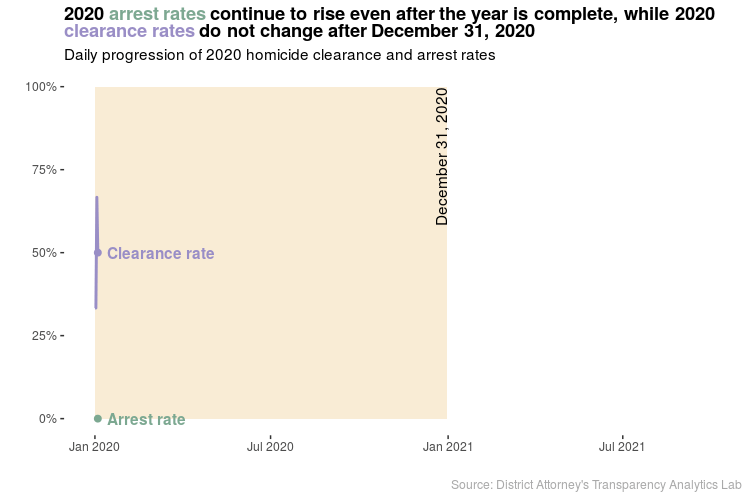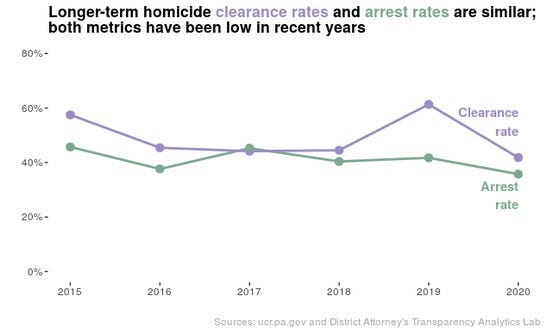
By Tyler Tran, Senior Data Analyst, DAO DATA Lab
What is a clearance rate?
The term “clearance rate” has seen plenty of press this year, with a record number of homicides but few arrests for those homicides. However, the term is not well-defined or understood.
Clearance rates are defined as the number of resolved cases in a year divided by the number of incidents in the same year (or month, quarter, etc). The clearance rate is a term defined by the FBI’s Uniform Crime Reporting program, to which police report data. This FBI definition of resolved cases includes both arrests and “exceptional clearances,” or instances where police have identified a suspect but are unable to make an arrest (for example, if the suspect has died).
If we focus on the homicide clearance rate in 2020 as an example, we would calculate the metric as follows:

Clearance rate compares all homicides that occurred in a year to all homicide arrests in that year, regardless of when the homicide took place. This means that clearance rates can be greater than 100% in some years. For example, if a small town saw one homicide in 2020, but that year police made arrests for that homicide and an earlier incident, the 2020 homicide clearance rate would be 200%.
Arrest rates
What is often reported as a clearance rate by the press doesn’t align with the FBI’s definition of the term. News articles sometimes inaccurately define clearance rate as “the percentage of killings that lead to an arrest” or “the percentage of cases considered ‘cleared’ by arrest.” To distinguish from the FBI definition of clearance rate, we term this metric “arrest rate,” or the proportion of incidents where an arrest has been made, regardless of when the arrest was made.
Re-using the example of 2020 homicides, we would calculate the arrest rate as follows:

Clearance rate vs arrest rate: pros and cons
We believe that arrest rate is generally more informative than clearance rate to show how many homicides have been ‘solved.’ The arrest rate directly links incidents and arrests and allows for an intuitive look at the work police are doing to bring accountability for the most serious incidents like shootings and homicides.
Arrest rates can be misleading if calculated in near-real-time: if we were to calculate an arrest rate for homicides that occurred last week, we would probably end up with a very low rate, because little time has passed for police to investigate and make arrests. The DAO has recently adjusted its reporting of arrest rates to only include homicides that are at least three months old to avoid this problem.
Clearance rate is more static over time, and it may be a better metric for historical reporting than arrest rates. Arrest rates can change as more arrests are made: the 2020 arrest rate will likely increase over time, as more arrests are made for homicides that occurred in 2020. Though much of the reporting on clearance and arrest rates focuses on relatively shorter periods of time, when considering long-term trends (several years), values for clearance and arrest rates often end up being similar.
 Both clearance rates and arrest rates only account for whether someone was arrested; the metrics don’t factor in whether a defendant is actually convicted. Given that cases are often open for a year or more (and even longer as courts were shut down during the COVID-19 pandemic) as court hearings progress, these rates would be difficult to report in a timely manner if they accounted for case outcomes.
Both clearance rates and arrest rates only account for whether someone was arrested; the metrics don’t factor in whether a defendant is actually convicted. Given that cases are often open for a year or more (and even longer as courts were shut down during the COVID-19 pandemic) as court hearings progress, these rates would be difficult to report in a timely manner if they accounted for case outcomes.Clearance rate and arrest rate can be valuable yet imperfect metrics if explained clearly and contextualized properly.
Why are clearance rates and arrest rates important?
To date, police have made arrests in only 33% of homicides that occurred in 2021 (this number is an arrest rate, not a clearance rate). The District Attorney’s Office is only able to file charges and prosecute cases once police make an arrest; that means that this year, the DAO has been unable to seek justice for the victims of the 67% of homicides where no arrest has been made.
District Attorney Krasner has publicly stated that law enforcement should be prioritizing shooting and homicide investigations to bring accountability; regardless of which metric is used, both clearance rate and arrest rate reflect the reality that the perpetrator of a homicide is unlikely to be arrested. Since 2015, far less than half of the homicides in Philly have seen an arrest. If we look at all shootings, the picture is even grimmer: since 2015, about 4 in 5 shootings in Philadelphia have not led to an arrest.

Low clearance and arrest rates have been a persistent problem in recent years, but historically, clearance rates were extremely high: in 1959, the homicide clearance rate was 96%. However, these high clearance rates were reflective of racist policing practices that led to numerous wrongful convictions, particularly of Black men.

Source: Philadelphia Police Department Annual Report, 1960 (Annotation and cropping by DAO)
If police don’t make accurate arrests in homicides and non-fatal shootings, the DAO can’t file charges or seek justice for the victims of gun violence. Police and prosecutors should be prioritizing the most violent offenses, and low clearance and arrest rates reflect the system wide failure to do so.